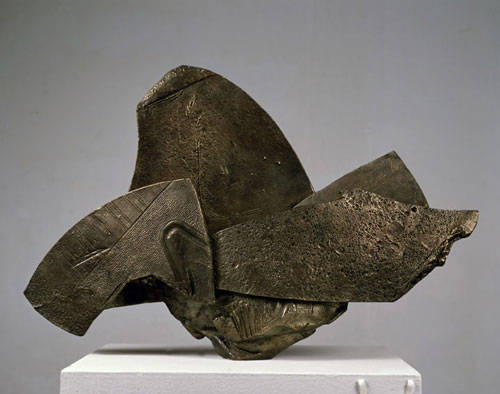
 Sculpture News at SculptSite.com
Sculpture News at SculptSite.com
Paul Soldner, Who Created Towering Ceramic Sculptures, |
| The New York Times by William Grimes Paul Soldner, a ceramist who put his own twist on the Japanese firing technique known as raku to create wildly spontaneous sculptural vessels, died on Monday at his home in Claremont, Calif. He was 89. His death was confirmed by his daughter, Stephanie Soldner Sullivan. Mr. Soldner was the first student of Peter Voulkos, the revolutionary founder of the ceramics program at the Los Angeles County Art Institute, who made it his mission to free ceramics from their traditional function as useful household goods and make them a vehicle for artistic and personal expression. Mr. Soldner incorporated the lessons of Abstract Expressionism and modernist sculpture in his work, throwing floor pots with expressionistically painted areas that rose to near-ceiling height. In 1960 he began experimenting with the 16th-century Japanese technique called raku, which is used to fire the vessels for the tea ceremony. It was little known in the United States, but Mr. Soldner's curiosity was aroused by descriptions in "The Book of Tea," by Okakura Kakuzo, and "A Potter's Book," by Bernard Leach. He constructed a makeshift kiln from a 50-gallon oil drum lined with concrete, fired a small bowl and ran to a nearby pond to cool it. "It was the ugliest piece of ceramics that you ever saw," said David Armstrong, one of his students and the founder of the American Museum of Ceramic Art in Pomona, Calif. Undeterred, Mr. Soldner fired another bowl, but this time he accidentally dropped it in a pile of pepper-tree leaves, which burst into flame. The resulting smoke imparted a gray-black, crackled finish to the glaze. Exposing raku ware to combustible material in an oxygen-deprived chamber, rather than letting it cool in the air or water, opened new possibilities that Mr. Soldner explored relentlessly, developing new textures and color effects in pieces that placed a premium on spontaneity. His technique became known as American raku, which he described as "pottery made within a mental framework of expectation, the discovery of things not sought." Paul Edmund Soldner was born on April 24, 1921, in Summerville, Ill. His father was a Mennonite preacher, and he attended Bluffton College, a Mennonite school in Ohio, with the idea of going into medicine. He was drafted into the Army and, as a conscientious objector, was assigned to the Medical Corps. He served with Patton's Third Army during the Battle of the Bulge, where he was wounded and awarded a Purple Heart. His unit was present at the liberation of the Mauthausen concentration camp, where the charcoal drawings that prisoners had made on barracks walls influenced him to become an artist. After earning a bachelor's degree from Bluffton in 1946, he worked as an art teacher and administrator in Ohio public schools. Initially he planned to become a photographer, but while studying at the University of Colorado, where he earned a master's degree in 1954, he took a course in ceramics and decided to become a potter. At the Los Angeles County Art Institute (now the Otis College of Art and Design), where he received his M.F.A. in 1956, he challenged the domestic scale of traditional pottery by coaxing monumental pots from the wheel, bringing them to a height of nearly eight feet in one continuous piece rather than sections. Only the physical limits of the kiln, and the studio ceiling, halted his upward progress - that and the fact that staring down into the spinning clay began to make him seasick. To execute his pieces, he invented new wheels and clay mixers that he sold for many years through his own company, Soldner Pottery Equipment. In 1957 he began teaching at Scripps College. He also began building a solar-heated house and studio in Aspen, Colo., using local rocks and wood. He spent summers there for the rest of his life and in the 1960s helped found the Anderson Ranch Arts Center in Snowmass Village, Colo. After teaching at the University of Colorado and the University of Iowa, he accepted a post as professor of ceramics at Scripps and Claremont University Center (now Claremont Graduate University) in 1969. In addition to his daughter, of and Aspen, he is survived by a sister, Louise Farling of Bluffton, and two grandchildren. Over the years Mr. Soldner experimented further with American raku. He used salt in the low-temperature firing process, imparting new colors - blushlike pinks, oranges and red - without glazing. He created novel textures and designs using paper stencils, templates of magazine photographs or the soles of running shoes. His sculptural pieces bristled with angular planes and squashed tubes that, in his later work, assumed a horizontal posture, influenced perhaps by his hobby of cultivating bonsai trees. His work is included in the collections of the Victoria and Albert Museum of Art, the Los Angeles County Museum of Art and the Museum of Arts & Design. Mr. Soldner was the author of "Kilns and Their Construction" (1965) and "Nothing to Hide: Exposures, Disclosures and Reflections" (2008). He was also the subject of several documentary films, the most recent being "Paul Soldner: Playing With Fire" (2005). |
 Paul Soldner an extraordinary artist/sculptor. Very nicely crafted article on his life by William Grimes. |
 "Pedestal Piece" by Paul Soldner |
More Sculpture News ....
Submit your SCULPTURE NEWS.
It's easy, just send us an e-mail
(click on Submit News in the left menu) with your pertinent information along with images, we'll take care of the rest. Sculpture makes our world a much better place in so many ways!
SculptSite.com, along with Sculptors and their creative genius all helping to bring the beauty and message of Sculpture to a hurried world.

